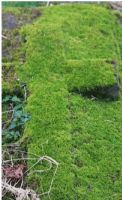

|
|
|
Moss Moss Date added: 13/02/2022 11:56:39 “A rolling stone gathers no moss” but take a look at this recent photo of moss on a fallen memorial cross. Fossil evidence shows that mosses existed hundreds of millions years ago, long before animals evolved. They belong to a division of land plants known as Bryophytes and are small, herbaceous and unlike most other plants, they have no roots but instead can absorb water and nutrients mainly through their leaves by osmosis. Photosynthesis enables them to use sunlight and carbon dioxide to create energy. They spread readily and can multiply by bits breaking off to form new plants and, although non-flowering, they do have a very complex form of sexual reproduction. Mosses grow chiefly in damp and shady places, such as woods and along streams but can also grow anywhere in cool humid climates. Identification can be difficult as there are about ten thousand species but the one shown is probably Cirriphylum Piliferum (common name Hair Pointed Feather Moss) unless someone out there knows better! Moss forms peat bogs and these are able to capture and store huge quantities of carbon from the air many times more effectively than trees and so help to maintain climate control. These retain water which helps to prevent flooding and reduces soil erosion. Using peat as a mulch and soil improver depletes the valuable bogs and burning it as fuel releases the carbon back into the atmosphere. In the past, sphagnum moss, with its antibacterial and analgesic properties, was used as an absorbent wound dressing in wartime field hospitals. Moss can be used for insulation and makes good animal bedding. The Japanese cultivate moss gardens to enjoy the calming effects of the smell and the various shades of green combined with lakes and running water. Some mosses contain complex sugars and are edible but are not very tasty although insects and invertebrates eat them. Moss is used as insulation and animal bedding. And finally, for you whiskey connoisseurs out there, the smokiness of your precious tipple is obtained by exposing the barley grain to peat smoke till it reaches perfection. © FNRC
Images related to this news article |
Website designed and maintained by Paul Thompson on behalf of the Friends of Newtown Road Cemetery.

